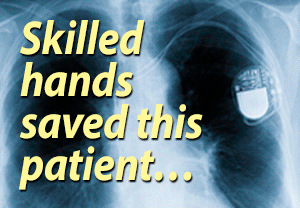 Afib Pacemakers in Development
Afib Pacemakers in Development
- by chiliman
- 2007-08-15 04:08:59
- General Posting
- 2055 views
- 2 comments
I've had my Guidant Insignia pacemaker which has caused a series of problems since its implantation a little over a year and a half ago.
I still suffer from atrial fibrillation despite 3 different ablations, and was told that a series of new generation technology pacemakers or ICD's that _specifically_ have algorithims and software to handle complex atrial fibrillation are in devlopment.
My current EP, who I am extremely happy with, told me that as soon as these become available (apparently the first one in testing is a St.Jude's) that he wants to change out my Guidant for one of the new afib-specific models.
Does anyone out there have an inside track to info as to what level of testing and trials (if any) these new generation pm's are in and when they anticipate U.S. deployment?
Thanks for any help.
2 Comments
Testing of PMs for AFIB.
by Stepford_Wife - 2007-08-15 11:08:08
Hi Chiliman.
Here is what I came up with, on the topic. I hope it helps.
~ Dominique ~
Clinical effectiveness
Introduction.
Single algorithms
The effect of most of the described algorithms when used in isolation remains unpublished. Murgatroyd et al. examined the effects of pacing after PACs to prevent AT in 70 patients [6]Go. With the algorithm enabled, PACs were reduced in 18 patients, increased in eight and patients with frequent AT episodes showed a reduction in the number of arrhythmia onsets. A circadian overdrive-pacing algorithm was assessed in 60 patients with paroxysmal AF [7]Go. The algorithm provided an elevated daytime base rate with an automatic reduction to a lower rest rate at night. Patients with sinus node disease and paroxysmal AF had a reduction in AF burden compared with fixed pacing at 70 bpm.
DAO is an algorithm developed by St Jude Medical to pace the atrium at just above the patients' natural circadian rate without employing fixed high rate atrial pacing. The ADOPT study evaluated the effectiveness of the DAO algorithm in a crossover manner in 288 patients with paroxysmal AF and sinus node dysfunction [8]Go. Patients were implanted with a Trilogy or Integrity pacemaker and were studied for six months. The pacemaker diagnostics were not used to calculate AF burden but patients recorded episodes of arrhythmia using an external ECG transmitter. A 25% reduction in symptomatic AF burden was reported (2.5% control versus 1.87% treatment) with the DAO algorithm enabled, however, the mean number of AF episodes, quality of life measures and number of hospitalisations were unchanged.
The effectiveness of atrial overdrive pacing was assessed using a DDD+ algorithm in 100 patients implanted with a Biotronik Inos2 CLS pacemaker. This algorithm increases the pacing rate on sensing a PAC by a programmable overdrive step size. There was no difference in atrial arrhythmia burden with different overdrive step sizes [9]Go. Closed-loop stimulation (CLS) in the same device, however, was shown to reduce arrhythmia burden compared with DDD+ and conventional DDD pacing [10]Go. CLS is a rate responsive algorithm that adjusts the pacing rate in response to an indirect measurement of autonomic tone. As paroxysmal AF onsets follow fluctuations in autonomic tone, it is hypothesised that increasing the pacing rate during this vulnerable period may prevent the development of the arrhythmia.
Analysis of the AF therapy data suggested that 28% of AF episodes were due to IRAF [2]Go. It has also been shown that PACs with shortlong sequences may be responsible for up to 70% of reinitiations of AF following cardioversion [11]Go. High rate pacing during the vulnerable period following restoration of sinus rhythm may therefore prevent IRAF. The effectiveness of an atrial pacing algorithm at preventing IRAF has been assessed in the Medtronic AT500 pacemaker [12]Go. This device offers temporary high rate atrial overdrive pacing soon after the end of an episode of AF. In 37 patients the number of AT episodes was unchanged with the algorithm enabled. The overall AF burden and quality of life were also unchanged. The device requires five consecutive sinus beats to confirm sinus rhythm has been restored and if several PACs occur, this can take some time. With the algorithm enabled, 29% of 439 episodes of atrial arrhythmia restarted during the algorithm intervention and 18% occurred before the algorithm had intervened. A faster detection of sinus rhythm and higher intervention rate may be required for this form of preventative pacing to be effective.
The effectiveness of some of the newer preventative pacing algorithms is under investigation in the multicenter Pacemaker Atrial Fibrillation Suppression Study (PAFS). A four-way randomised cross over design is assessing the impact of rate soothing, ventricular rate stabilisation and post-AF response in a group of patients with the Selection device and paroxysmal AF. Endpoints include AF burden, sinus rhythm duration, quality of life and symptoms and results are expected in late 2004.
Combined algorithms
Many studies have assessed the effects of combined atrial pacing preventative algorithms on reducing AF burden and early data have been presented as abstracts. The PIPAF study assessed the effect of preventative algorithms in 38 patients with paroxysmal AF and early results were presented at the American College of Cardiology scientific sessions in 2002 [13]Go. The pacemaker was the Chorum 7334 system (ELA Medical, Paris, France) and the algorithms studied were sinus rhythm overdrive (achieves permanent atrial pacing just above the sinus rate), post-extrasystolic suppression (controls the variation of cycle length after a PAC) and acceleration on PACs (temporarily increases pacing rate upon frequent PACs). There was no significant change in AF duration or number of AF episodes with therapies on or off. The investigators noted a reduction in AF in 20 patients, an increase in 14 patients and four patients remained symptom free throughout the crossover phases.
The AT500 pacemaker has three atrial preventive pacing algorithms designed to prevent atrial arrhythmias; atrial rate stabilisation (responds to PACs), atrial preference pacing (overdrive pacing) and post-mode switch overdrive pacing. In 31 patients, the algorithms reduced the mean number of arrhythmia episodes but the overall time in arrhythmia was unchanged [14]Go. The AT500 verification study investigated the effectiveness of preventative and termination algorithms at reducing overall AF burden in 325 patients with a conventional indication for pacing [15]Go. Though preventative pacing algorithms increased the median percentage of atrial pacing from 62% to 97%, there was no difference in the number of atrial arrhythmias or in the overall arrhythmia burden. The ATTEST investigators examined data from 324 patients implanted with the AT500 pacemaker [16]Go. Patients had a conventional indication for pacing and at least one episode of AF in the preceding year. All prevention and anti-tachycardia therapies were enabled. The median percentage of atrial pacing was 98% in the ON group and 75% in the OFF group. There was no difference, however, in median AF frequency (1.3 episodes/month ON versus 1.2 episodes/month OFF) or in overall AF burden (4.2 h/month ON versus 1.1 h/month OFF).
The AF therapy study evaluated the effectiveness of combined pacing algorithms using the Selection 900 platform in preventing AF in 372 patients with paroxysmal AF [17]Go. Two-thirds of the patients had no conventional bradycardia indication for pacing. Pace conditioning, PAC response, PAC suppression and post-exercise response were enabled in a parallel manner for two months and compared with support pacing. Preliminary results from a subset of patients have indicated a 30.4% reduction in AF burden using combined preventative algorithms and an increase in sinus rhythm duration of 68%. The median duration of AF, however, in the study was 0 h per day indicating that many patients were free of AF throughout the study. The prevent-AF registry examined the effects of individualised preventative algorithms in 32 patients with sick sinus syndrome and paroxysmal AF using the Selection pacemaker [18]Go. After a maturation phase and a period of monitoring, the diagnostic information from the device was examined. If PACs were seen before the onset of AF the PAC suppression and post-PAC response algorithms were enabled. If no PACs were seen before arrhythmia onset then pace conditioning was activated. Post-exercise response was recommended if a rate decrease was seen prior to AF onset. If no AF episodes were detected on the device diagnostics then all algorithms were deactivated. Nine patients had all four algorithms enabled. The median AF burden for the group of 32 patients reduced from 3.9% to 1.3%. Nineteen (50%) of patients experienced a reduction in AF burden of 50% or more.
The use of algorithms in combination in the Selection pacemaker appears to lead to pre-dominance of pace conditioning over the other algorithms with the algorithm post-exercise response becoming largely redundant. Pace conditioning and rate soothing cannot be enabled together. Combined preventive algorithms can also lead to quite rapid rises in pacing rate. For example, a rate increase of 15 bpm induced by pace conditioning upon sensing a physiological atrial event may be followed by another increase of 15 bpm by PAC suppression if a PAC is sensed. A maximum AF therapy rate can be programmed to prevent undesirable high rates (that may be problematic in patients with heart failure or ischaemic heart disease). Consistent high rate atrial pacing does, however, appear to be symptomatically well tolerated by most patients with paroxysmal AF [9,Go19]Go.
Hybrid therapy
The use of synergistic antiarrhythmic drug therapy may influence the efficacy of preventative pacing algorithms [20]Go. Barnay et al. studied 103 patients with documented paroxysmal AF implanted with the ELA Medical Talent AF pacemaker [21]Go. Analysis of antiarrhythmic drug use identified that patients on sotalol had the shortest AF duration and a greater reduction in AF episodes. Conversely, analysis of 75 patients using the Biotronik DDD+ algorithm suggested that patients on betablockers (in particular sotalol) had minimal or no benefit from overdrive pacing [22]Go. These disparate results may be due to different types of AF being treated by different devices. Further studies are clearly needed but it is important to remember that any synergistic or hybrid beneficial effect of the combined pacing and drug approach may simply be the addition of two limited and independent antiarrhythmic actions [23]Go.
It is possible that the atrial lead location may also have an effect on the success of pacing therapies. The ASPECT study conducted by Padeletti and co-workers examined the effect of atrial septal pacing in 148 patients, and non-septal atrial pacing in 150 patients with an AT500 pacemaker [24]Go. Combined preventative algorithms were enabled for three months on and off. Patients with septal pacing had a significant reduction in symptomatic atrial arrhythmia episodes. Both groups had a reduction in PACs but neither site reduced overall (symptomatic and asymptomatic) arrhythmia burden or onsets. The same group studied 46 patients with paroxysmal AF and sinus bradycardia who were implanted with the Medtronic Thera pacemaker [25]Go. Patients were randomised to right atrial appendage pacing or interatrial septum pacing with a constant atrial pacing algorithm enabled in a cross-over manner for three months. Although there was no difference in AF burden with the algorithm enabled for both pacing sites, there was a reduction in AF burden for interatrial septal pacing compared with atrial appendage pacing (47 min/day versus 140 min/day). The PASTA study should provide further data on the importance of the atrial pacing site [26]Go. This prospective study is evaluating the effects of right atrial free wall, right atrial appendage, coronary sinus ostium, and dual site pacing sites on atrial arrhythmia burden using the Selection 9000 pacemaker.
Future directions
Ventricular "proarrhythmic" pacing
Those patients who need a dual chamber pacemaker for reasons other than AF may have a smaller advantage from atrial preventative pacing. This is because DDD pacing, even with a lower rate limit of 40 bpm and long atrioventricular delays, often results in right ventricular pacing. Some studies have demonstrated that long-term right ventricular apex pacing is detrimental to left heart haemodynamics, resulting in a reduced cardiac output, mitral valve regurgitation and a higher incidence of atrial arrhythmias [27Go29]Go. This effect has recently been demonstrated in a study randomising patients to AAIR or DDDR pacing for the treatment of sick sinus syndrome [30]Go. The incidence of AF in the dual chamber group was significantly higher (7.4% versus 23.3%) during three-year follow-up. Those patients with a long atrioventricular delay (who were paced in the ventricle 17% of the time) had less AF than those with a short atrioventricular delay (who were ventricular paced 90% of the time). The left atrium enlarged significantly in the DDDR group during follow-up and those paced with a short atrioventricular delay had reduced fractional shortening on echocardiography. Patients implanted with a dual chamber pacemaker may therefore have an artificially higher AF burden if they have any amount of ventricular pacing, even before preventative algorithms are enabled. Mechanisms to reduce right ventricular pacing or studies of alternate-site ventricular pacing are required.
Device advances
Memory capabilities of modern pacemaker platforms are improving and stored intracardiac electrograms are becoming standard on many dual chamber pacemakers. These electrograms allow an accurate examination of atrial arrhythmia onsets, arrhythmia terminations, the degree of arrhythmia organisation and the true effectiveness of pacing therapies to be evaluated [31]Go. The addition and careful programming of atrial anti-tachycardia pacing therapies is likely to reduce AF burden further [32,Go33]Go. Digital systems are now being developed with the potential to offer clearer electrograms, be software upgradeable and have methods of eliminating far-field R wave sensing.
The appropriate patient
Choosing the appropriate patient is likely to remain one of the difficulties in achieving a benefit from atrial preventative pacing. Many patients have no AF after device implantation and may have simply benefited from atrial pacing. In the ASPECT study for example, 22% of patients had no atrial arrhythmia during the entire six month randomisation period [24]Go. Patients also need to have at least a moderate AF burden so that pacing algorithms have a higher role to play. The inclusion criteria of the ASPECT study required just a single episode of AF in the preceding year and it will clearly be difficult to demonstrate a benefit from pacing therapies if overall AF burden is low [16]Go.
Conclusions
Preventative pacing for AF is in the early stages of development. The majority of the device companies now have pacemakers with atrial pacing algorithms designed to prevent AF. They are all very similar in operation and generally work by overdrive pacing the atrium or by responding to PACs. There are clearly groups of patients who benefit from atrial preventative pacing algorithms but there are also many who do not. What remains unclear is how to determine which patient will benefit. Methods to reduce ventricular pacing are important and the development of detailed intracardiac electrograms will allow the true effectiveness of pacing algorithms to be assessed.
Acknowledgements
This work formed a component of a Doctorate of Medicine thesis at the University of London and was partly supported by an educational grant from Medtronic (UK) Ltd.
You know you're wired when...
You run like the bionic woman.
Member Quotes
Stay positive and remember that your device is your new best friend.


.png)


Still hoping...
by chiliman - 2007-08-15 01:08:20
Dominique...
Thanks for the info; very interesting read.
The article you cited mentions "...Endpoints include AF burden, sinus rhythm duration, quality of life and symptoms and results are expected in late 2004."
As of August 2007, the NEWEST generation of afib-specific pacemakers are YET to be released even though many current pm have versions of these afib control algorithms you cited.
The two EP's that I deal with (who are both very savvy techs) told me that the algorithms alone with current models have been shown to be MINIMALLY effective in afib treatment.
This, unfortunately is the current "state of the art." Pacemakers on the market now are not especially good at truly controlling persistent atrial fibrillation.
Which brings me back to my original question: When?
I'm hoping someone who reads or posts here, and who might be working for or with one of the Pacemaker manufacturers, would have a lead on the release of these newer and far more effective AFIB-specific devices that are in development.